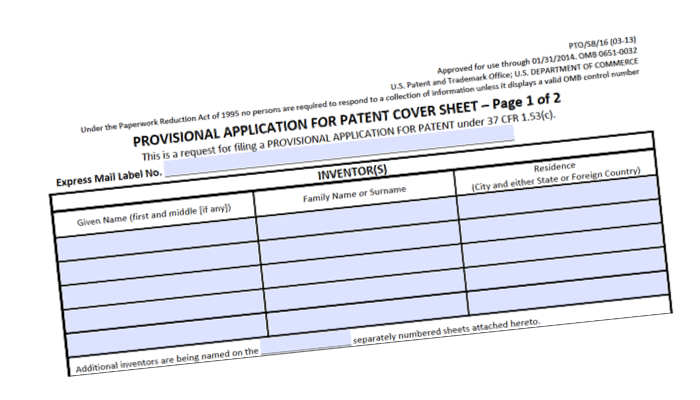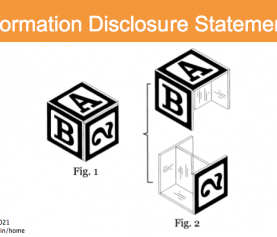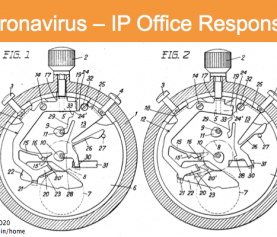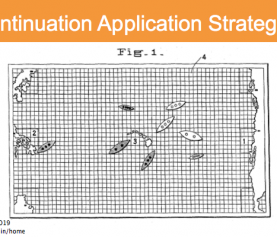Provisional patent application form and strategy
You want to file a patent application or provisional patent application to protect your innovation, and you’re looking for a provisional patent application form. There’s good news and bad news: the bad news is that there is no one-size-fits-all provisional patent application form. The good news is that there is a patent prosecution strategy that makes sense for startups, entrepreneurs, and businesses of any size that are budget-conscious.
There is no provisional patent application form
There is no single provisional patent application form because each patent application must describe the innovation. Of course, each patent application has the same sections, but the content of those sections must be tailored to each invention. (And there are USPTO forms for the paperwork that is required for each patent application, but those don’t describe or protect the invention). To write a patent application or provisional patent application, you need to describe an invention in enough detail to show that it is new, not obvious (in light of what is already known), and useful, and you need to describe it well enough so that anyone familiar with that subject area could read your patent application and know how to carry out your invention.
Can you use a provisional patent application form on the cheap?
You may consider trying to write and file your provisional patent application yourself. Perhaps you’d use another provisional patent application as a guide. Maybe you’d spend a little money on a law-services website – I won’t name or link to them here, but they operate by having you fill in questions on a form, and your answers become the text of the patent application. The problem with this do-it-yourself approach is that, while you know your field very well, you don’t know how to write a patent application. Using one of those services will almost certainly lead to one of three unhappy outcomes: 1) you give up on your patent application, 2) you continue spending money and wind up with a patent of no value, or 3) you give up on the law-services website, and pay a patent attorney to fix your patent application.
A better provisional patent application strategy
There is a better provisional patent application strategy, that makes sense for entrepreneurs, startups, and businesses of any size. I’ve written on patent application strategy before, but not in detail about what I call a “staged provisional patent application strategy.” If you are still developing your invention, or if you are budget-conscious, consider this strategy rather than trying to using a “provisional patent application form.” The staged provisional patent application strategy can also make sense if you’ve made a public use or disclosure of the invention, or offered it for sale, and need to file an patent application as soon as possible: you could file a provisional patent application quickly, and then more fully describe the invention and file another provisional patent application or a non-provisional patent application.
A staged provisional patent application strategy
With a staged provisional patent application strategy, you work with me to write your patent application in stages. We plan to file two or more provisional patent applications and a non-provisional patent application, all within a year. By doing so, you spread the cost of describing your invention across more than one application, so that each one costs only a portion of what a single, full, patent application would cost. And you allow yourself time across the course of a year to make refinements and additions to the invention. If you haven’t fully developed or refined your invention, this strategy can benefit you by allowing you to get some protection early, and more protection for additional components or details of your invention as you develop them. In contrast, waiting to start on any patent application until you have your invention fully fleshed out can have bad consequences for your intellectual property: you may have made a public disclosure or public use of your invention, or someone else may beat you to filing a patent application, among other possibilities.
How does a staged provisional patent application strategy work?
Suppose your invention is (eventually) A, B, C, D, and E, which can be put together in a few different combinations or orders: ABCED, ABDE, ABECD, and so on. In January, you’ve only thought of A, B, and D – but you’re sure there’s more you’re going to figure out as you and your team keep working on it (and see my post on patent inventorship, for key background information). We file an application describing ABD, and ideally, summarize what exists before your invention, problems with what exists, and how your invention improves on it. By April, you’ve added C to the invention, and this lets us describe other shortcomings in what already existed, and how your invention improves on them. Working with you, I write that up and file a second provisional patent application. Perhaps you iterate this once more, in July, adding E to the mix, and introducing a few more ways that the components or steps of a method can be put together. We write another provisional patent application. Finally, around nine months after filing the first provisional patent application, we start discussing whether there are any final changes to be made to the invention. We write up the patent application as a full non-provisional patent application, making any changes or additions, and file it before a year has passed from the first provisional patent application, taking advantage of the filing dates of each of the provisional patent applications, and their increasing levels of detail and disclosure.
The advantages of this staged provisional patent application strategy
The advantages include: spreading the cost of writing a patent application with the required level of detail out over the course of a year, and letting you start towards some patent protection while you develop the innovation. Each provisional patent application costs less in my fees and USPTO fees than a full patent application. Writing a filing multiple provisional patent applications will likely cost a small percentage more than writing a single patent application, but if 1) you haven’t developed the final invention, and/or 2) you need to spread the cost over a year, this staged provisional patent application approach can work well. See my blog post on patent application cost for information on likely price ranges for patent applications and patent strategy advice, and my blog post on filing-entity size for info on whether you qualify and could save on filing fees..
When does this strategy not make sense?
If you have already fully developed your invention, you should not pursue this strategy. Instead, I would work with you to write and file a provisional patent application or non-provisional patent application with a full disclosure of your invention. In general, you should put as much detail as you have conceived of into any patent application.
Have questions?
Do you have questions? Agree or disagree? I’d be glad to hear your comments. Call me at 617-340-9295 or email me at my Contact Me page. Or, find me on Facebook, Twitter, Google+, LinkedIn, Google Local, or Avvo.







[…] it. If you need to file a provisional patent application in an emergency, or are following the staged provisional patent application strategy I describe in this post, we may postpone gathering some of the details of the […]